new_era_writeup
iBoot: A New Era
Part 1: Capabilities and Objects
Big thanks to Lily (@BendyCatus), Justin Sherman (@jsherma100), and Siguza (@s1guza)…
and everyone in Hack Different, love y’all :D
Dedicated to Jido Tarek. الله يرحمك.
Contents
- Introduction
- iBoot?
- Finding Buggo
- The Microkernel Dream
4.1 Capabilities?
4.2 UFO - Unidentified Flying Object - Last Notes
(1) Introduction
In May of 2022, I began my research into FireBloom and how it worked. This new fancy-schmancy addition to the compiler used to build iBoot works to prevent common memory safety issues (such as buffer overflows or type confusions) when using dynamically allocated objects. I was super interested in the type safety mechanism, but I was a bit stumped on how it all worked. My frustration found me lazily scrolling over some iBoot disassembly when I came across some recovery mode strings. I realized I’d never experimented with recovery mode, so I decided to put my device into recovery and open a shell. After entering the recovery shell, I started typing random commands……
and after 8 commands, iBoot stopped giving me responses. Hm. Weird.
In my continued frustration, I repeatedly exited and entered the iBoot shell…and I was greeted with a pleasant surprise:

iBoot panicked! Was this really a bug? That’s all it takes? What was happening exactly? Can this bug be exploited to yield full control over iBoot?
(2) iBoot?
For the more experienced readers, feel free to skip this section. For the unfamiliar, iBoot is a piece of proprietary software called a boot loader. Essentially, a boot loader is responsible for handling and starting the lower level parts of a system. For example, a boot loader on a smartphone may turn on the display, ensure the logic board is operating at a safe voltage, turn on DRAM, among many, many other tasks. iBoot is Apple’s boot loader. It runs on every piece of hardware that contains Apple Silicon chips, and it’s responsible for lots of system bring-up. It evens draws a nice Apple logo on your iPhone when booting up.
Because this loader has so many tasks to accomplish, it runs before the actual iOS kernel runs, giving it lots of power. It has access to more parts of the system, and if its integrity is compromised, it may compromise the security of the user, not to mention break every guarantee that hardware measures have for the kernel at runtime. Therefore, it’s almost the holy grail of iPhone hacking.
A panic is when a piece of software (typically a kernel or boot loader) resets the system state in a fresh state as a result of an unrecoverable event (like a data abort). This is usually bad for a user because it means something went wrong with your system, but great for a hacker (like myself) who wants to break a system intentionally.
(Sidenote: you cannot modify iBoot. It is both encrypted and signed, and Apple does not provide an unlocking mechanism found on other devices.)
(3) Finding Buggo
Production builds of iBoot (mostly) do not print raw strings to the console. Instead, they are HMAC’d, or in other words, a string which is locked behind a specific cryptographic algorithm called an HMAC. This means we have no real way of knowing what the string is. It just looks like garbage numbers and letters. All I knew at this point was that iBoot was panicking, but it did give me an HMAC’d string, so it was time to find the HMAC in iBoot.
For anyone following along, I’ll be reversing the iPhone 11 Pro’s iBoot on iOS version 15.0.
IVKEY: 5AFE47FA756A56E543AF5EEF4F9074F7E7A3038CBBD979AE7B4410A6464A4C3E6A0DCEC3FE424AEE0B32745B71860D8E
After a quick search in Ghidra, I landed here:

Awww, looks like a simple count check. Of course, with any panic, you should look deeper and check if there is an underlying issue. The only cross-reference to this function was task_setup_stack, which is called from both an initialization function called when iBoot starts up, and another function. The latter was more interesting to me because the former is only ever called when iBoot starts up. So, it couldn’t be where I was panicking. After following the last XREF, I landed somewhere very interesting:

Woah, is this some sort of command handler? If you follow the only XREF you land at….a part of an exception handler?!
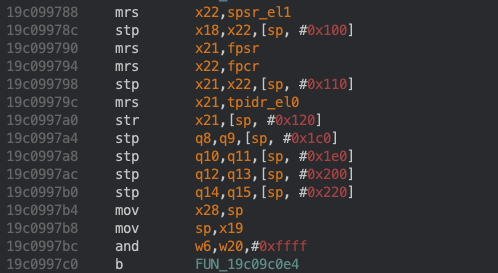
iBoot has a syscall handler! If you follow the XREF to the snippet showed above, you can see that ESR_EL1 is stored in x20, which is the target of the switch statement. When an svc instruction is executed, the immediate is stored to ESR_EL1 (with some other things). This is super cool.
If you search for a svc 0x41, you’ll find only 1 in iBoot:
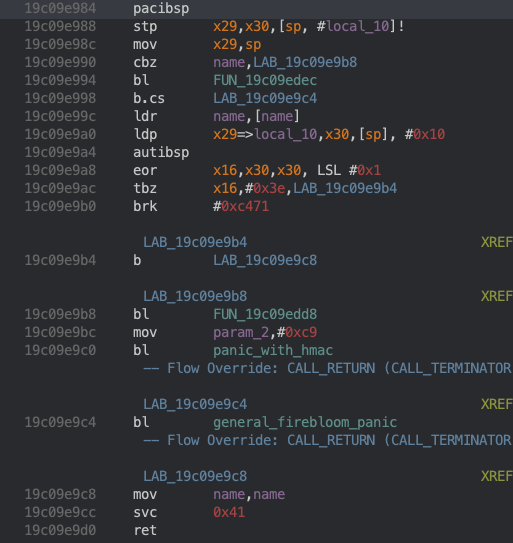
This looks like a general wrapper for the syscall, but what’s more interesting is what you observe when you look at the cross references for this function:
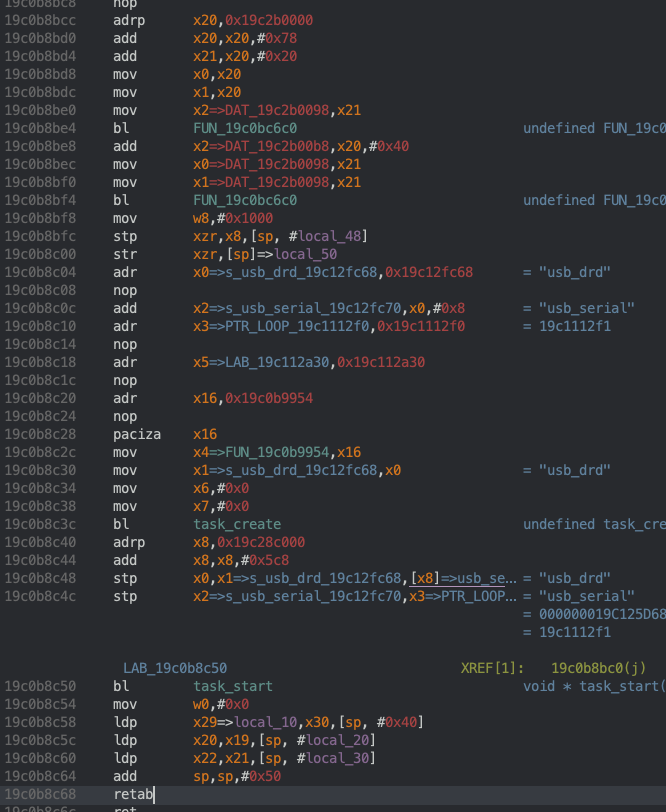
task_start is essentially syscall 0x41! Super awesome. This is pretty obvious since names like “usb_serial” or “idleoff” are passed as arguments to task_start. This was the first hint to me that there was a kernel hiding in iBoot (along with the cheeky “Microkernel” tag in iBoot’s console banner :P).
task_start only had a limited number of XREF’s, most of which were not important because they were only called in functions that were also called once. The very last XREF was the only interesting one:

Ah, it looks like a simple error. Although the necessary conditions should eventually be reached to stop this while loop, it looks like ultimately task_start my have been getting called in excess of 0x20, which lead to the check failing and the corresponding panic.
Apple has patched this in their latest iOS 16 beta. For anyone who needs the key, enjoy: 047CAED3912AFB8B647F7B1743B56034E6C5EF2624C8282F6E073B11E1DEF06E548EA3298872C61D3B994E1C8ACABC62
Source: https://twitter.com/matteyeux/status/1535138636273963008
And here’s the patch:
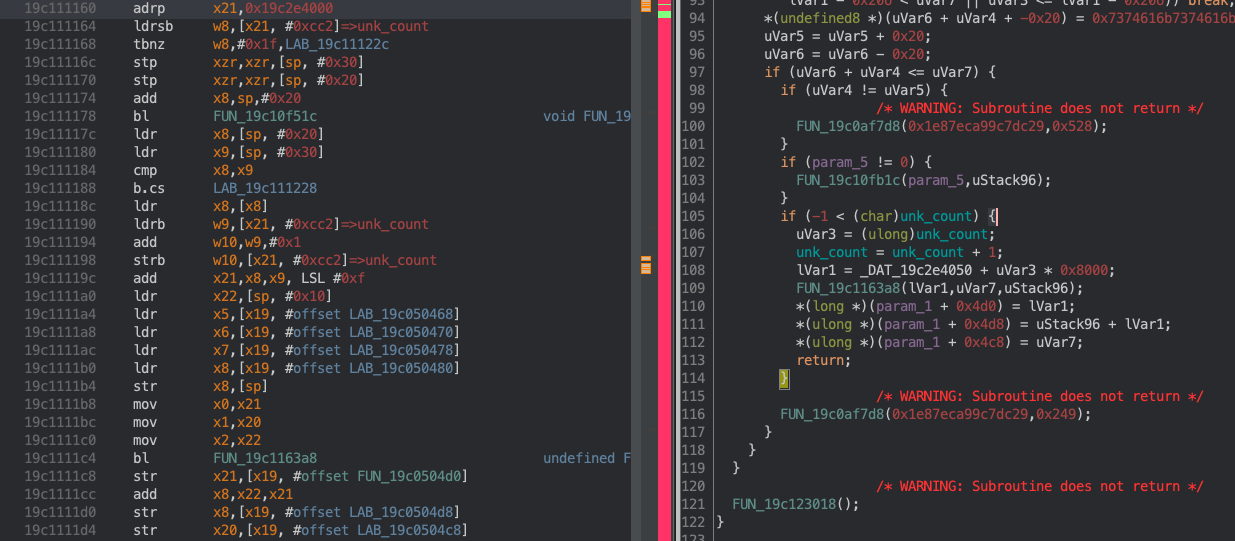
From what I can tell from the call stack, the old assembly, and the patch, 0x20 seems to be an accidental, arbitrary limit that was set for some resource that’s allocated per-task. If so, the new patch makes sense because there should (technically speaking) be no limit for the amount of tasks in a kernel. All this patch does is allow the count to be incremented until it overflows.
At this point, I was pretty disappointed. This did not lead to a very useful bug. On the flip side, I was eager to jump back into reverse engineering the kernel I thought existed in iBoot. A little spoiler to the reader: all of this is the tip of the iceberg. iBoot has significantly changed, and we’re in a new era. Gone are the days of the tiny iBoot task subsystem. Welcome to “the Dream”.
(4) The Microkernel Dream
https://twitter.com/tjkr0wn/status/1535005157947326464
One of my favorite ways to reverse engineer a new component is to compare the startup routines of the same binary. In this instance, I went through and compared the startup routines of iBoot before and after this supposed kernel was added. When comparing the 15.0 iBoot to a 14.X iBoot, I noticed an important difference. The startup routine jumps to an unfamiliar function. Previously, iBoot went through this flow: _start(...) -> _main(...). However, this iBoot had a new flow _start(...) -> _intermediate(...) -> _new_main?(...):
_main(...) in 14.X
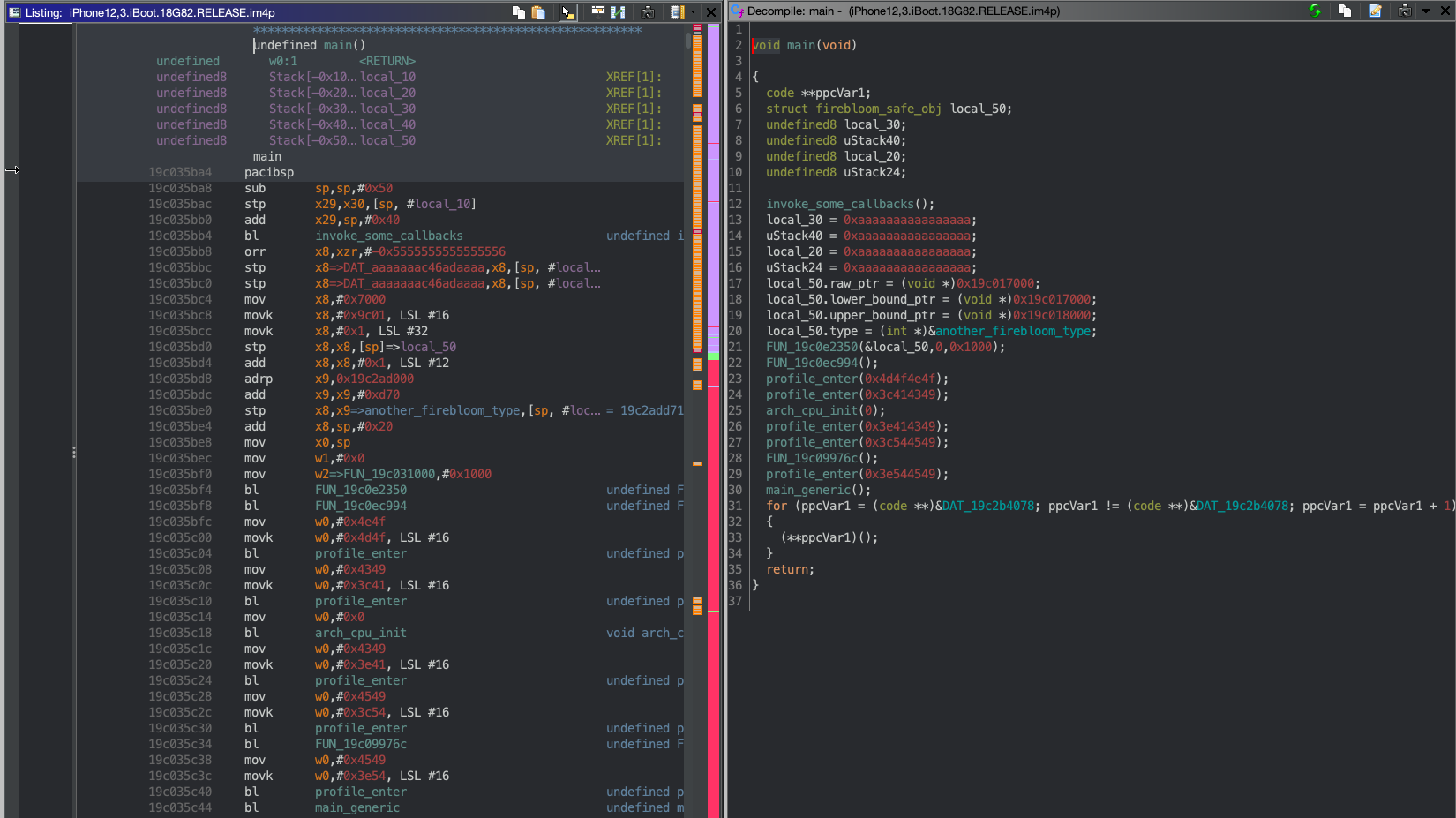
_intermediate(...) in 15.X
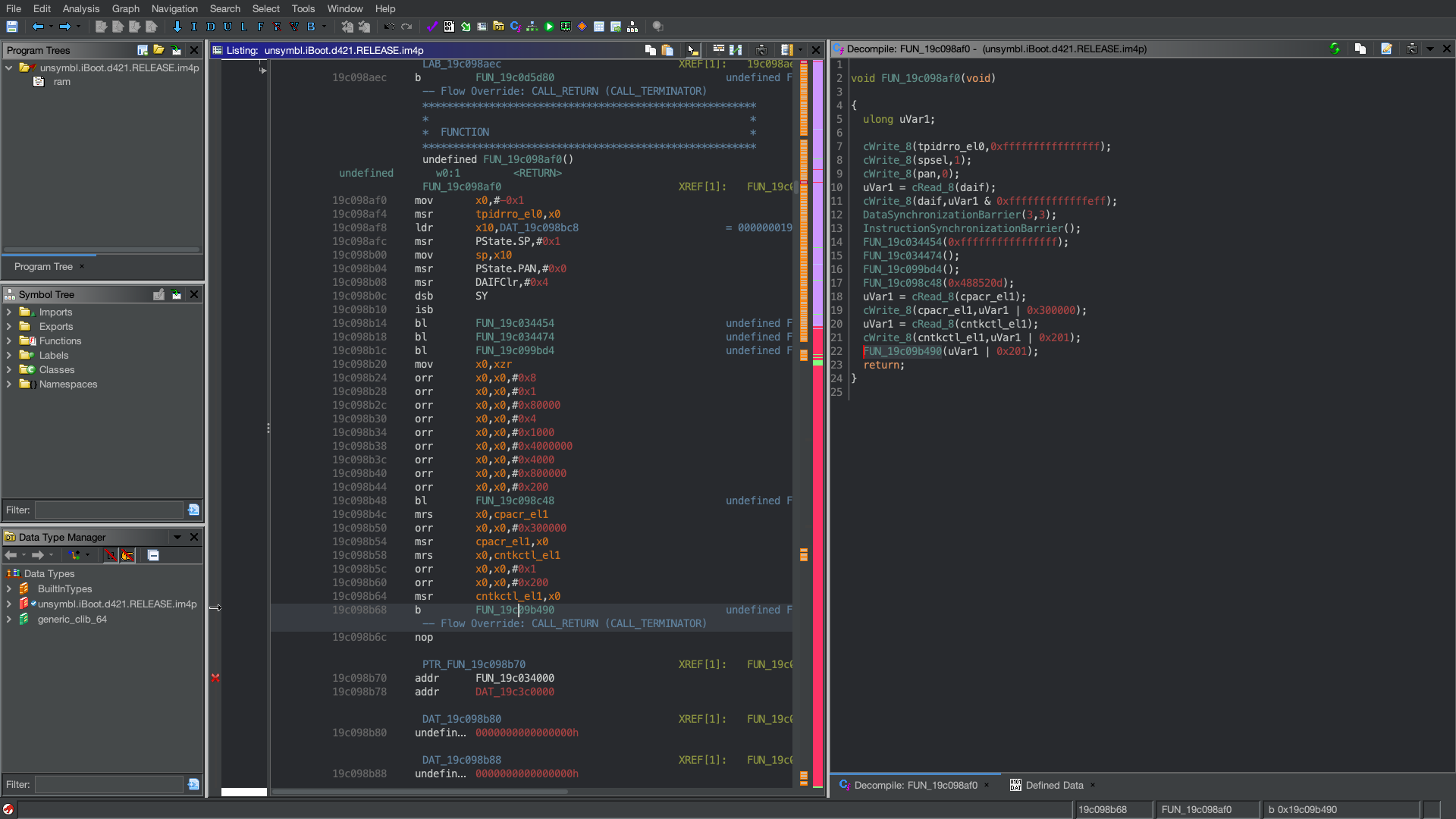
_new_main?(...) in 15.X
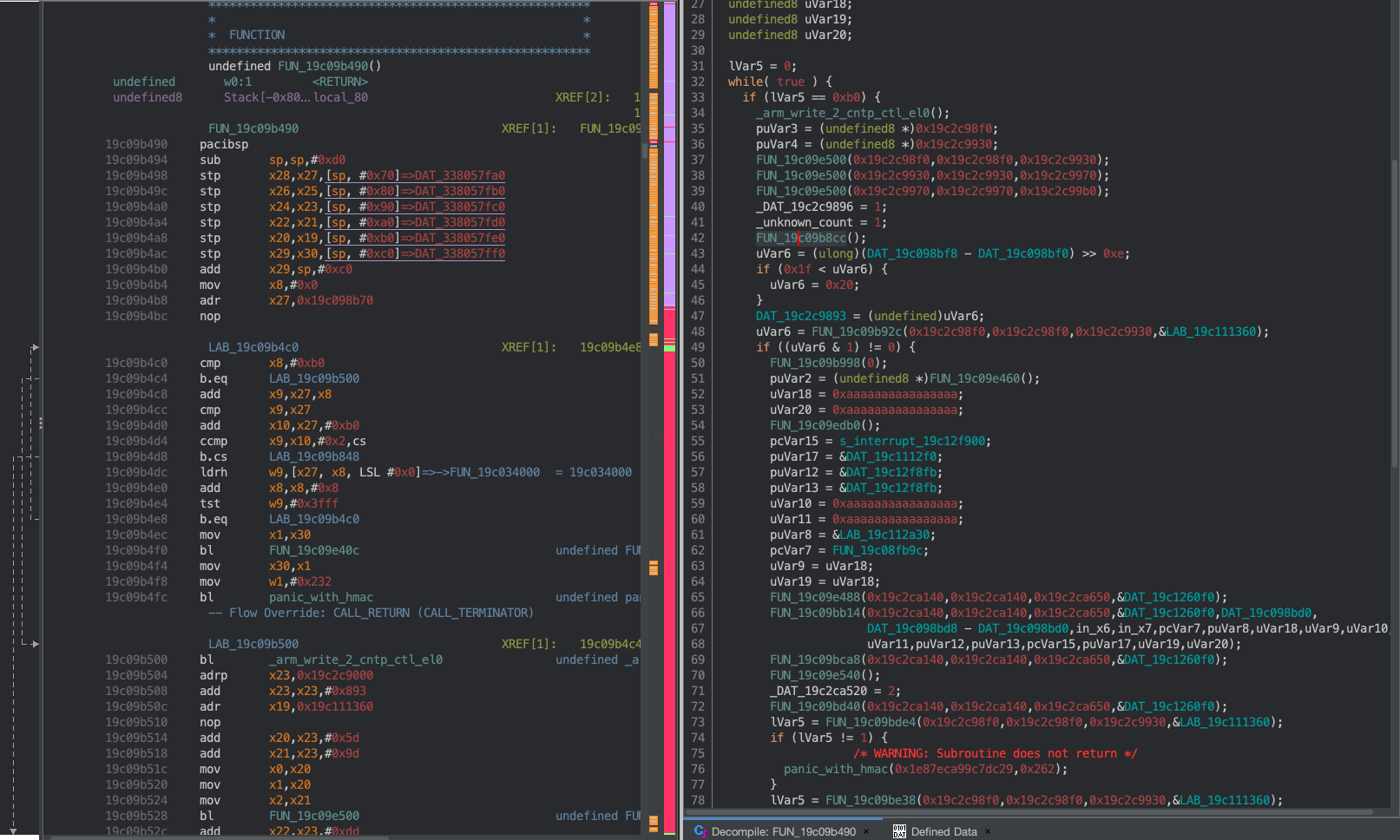
These _main(...)’s looked quite different from each other. In fact, not even the main_generic(...) found in the 14.X iBoot looked similar to 15.0’s _new_main?(...), so what gives?
A large amount of code like this may seem daunting, but nobody is familiar with any piece of code as soon as they look at it, so I began just clicking around and seeing what this completely new function does. Well, as it turns out, this is not a “new version of main(…)”, but rather microkernel_init(...). It does a lot of the initialization for important things the microkernel needs to run and operate.
I quickly discovered something interesting in a function that is called within the new microkernel_init(...):
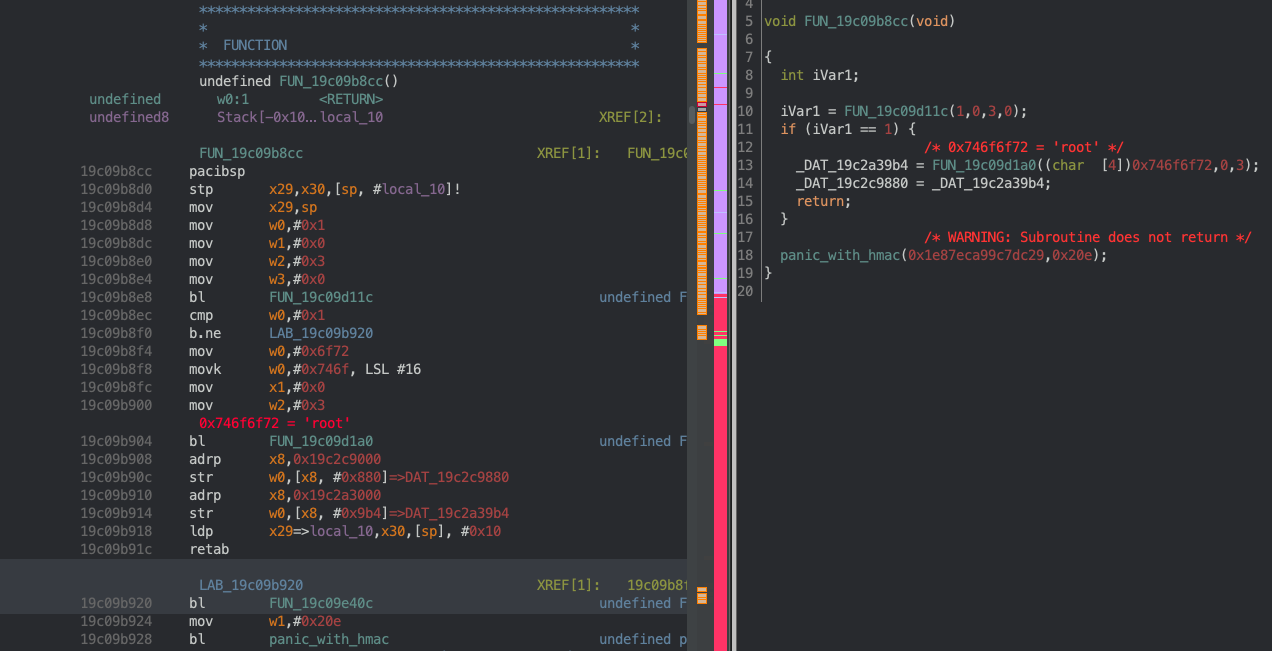 Figure 1
Figure 1
(4.1) Capabilities?
Hm, looks like this code might be creating a ‘root’ process and setting a global pointer to the returned task pointer. But, it’s probably better to keep going and not draw conclusions yet. What about the function call above? It seems to have some basic arguments, and it looks essential to initialization, so let’s look further:
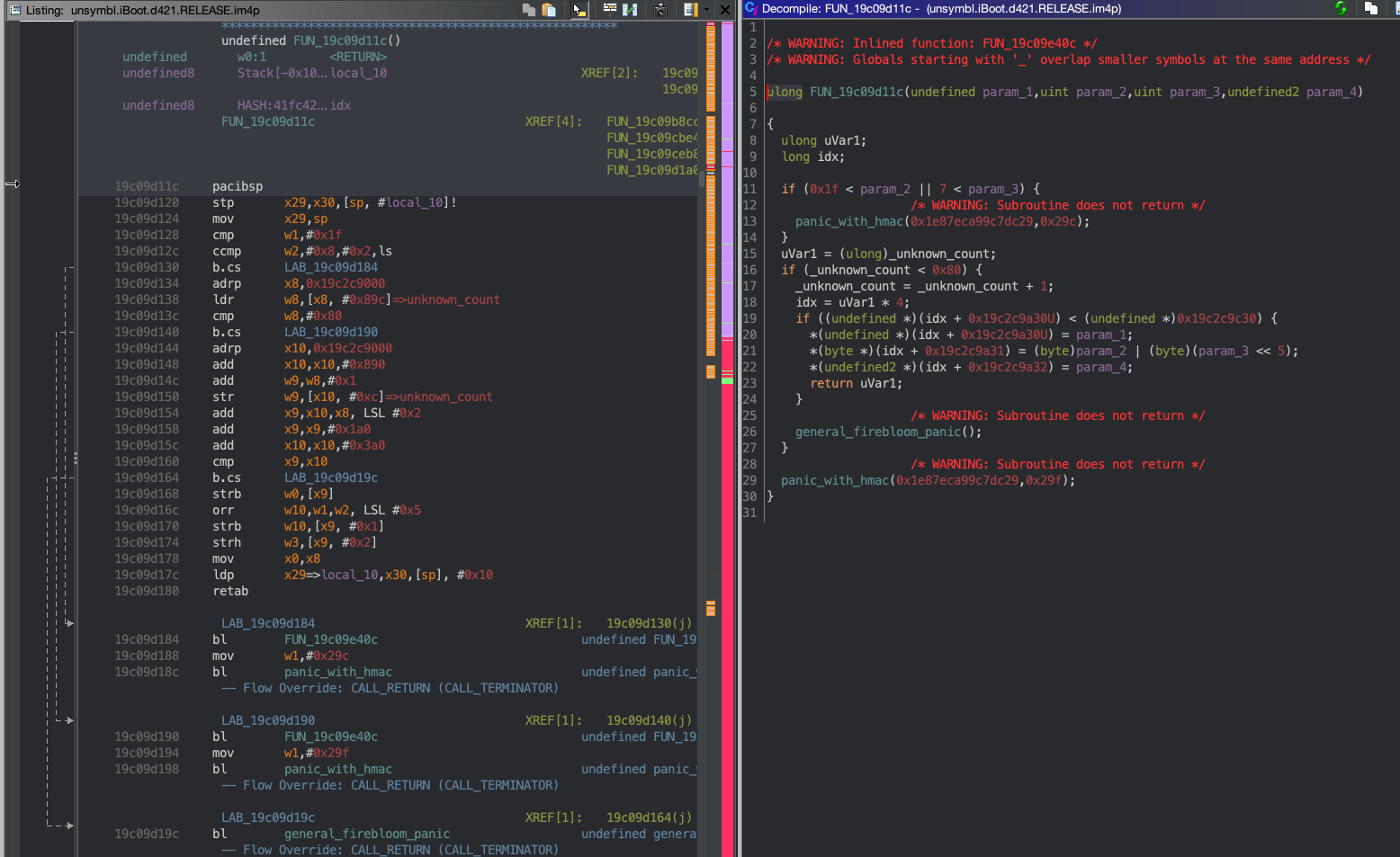 Figure 2
Figure 2
Looks like a list of bytes (notice the strb instructions, except the strh) that are created from the arguments passed in. This list seems to be maintained with a count that’s incremented after every invocation. This count also starts at 1 because it is set to 1 before the function in Figure 1 is ever invoked. Note: after this function finishes execution, _unknown_count = 2. I kept an eye out for the address 0x19c2c9a30, and the others in this screenshot…
When I hopped back to the supposed ‘root task’ function seen in Figure 1, I found a call to a function at 0x19c09d3a4 that uses the address(es) above:
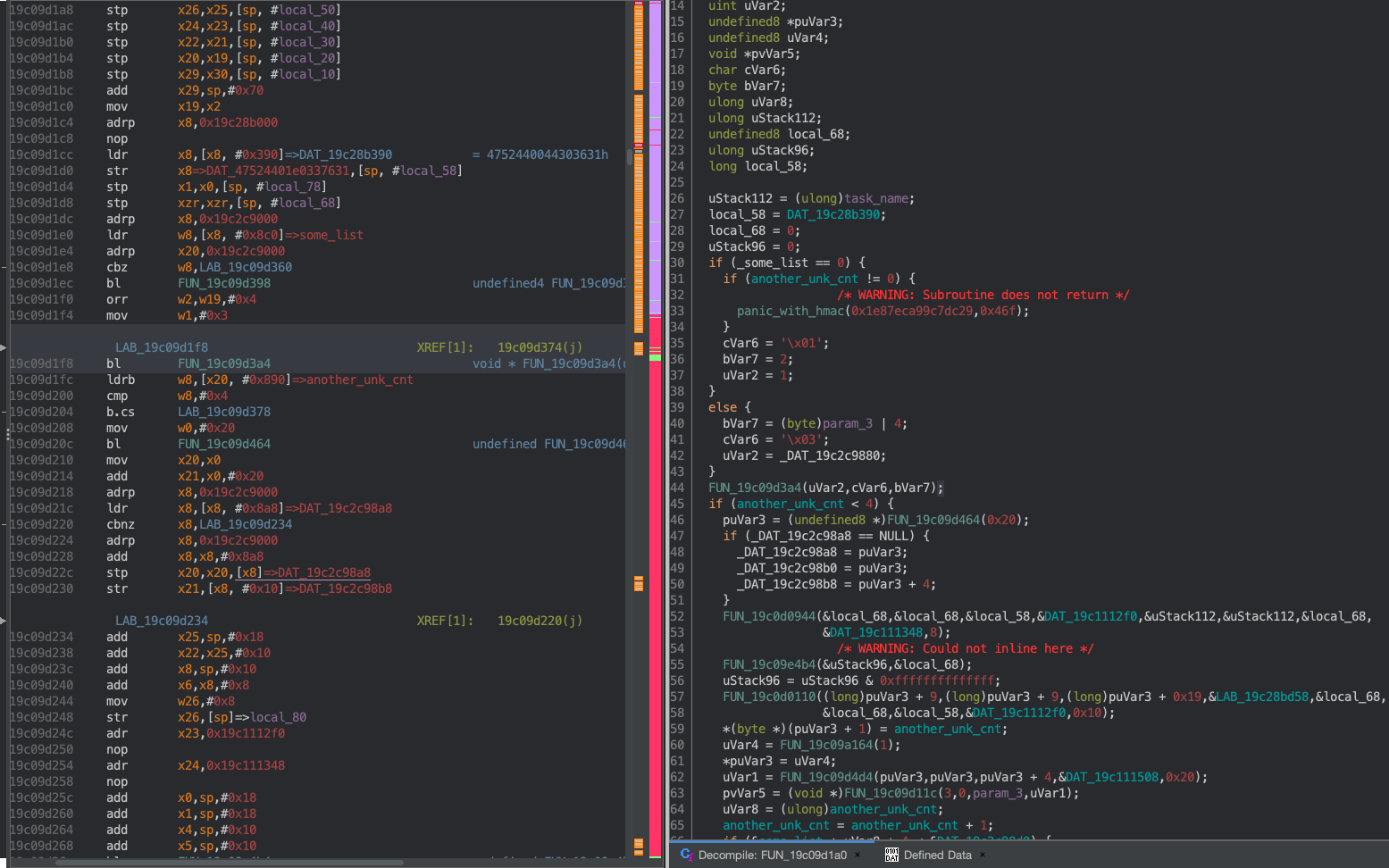 Figure 3
Figure 3
 Figure 4
Figure 4
Let’s go back to Figure 2. If we work through what the first values of this list are, we find this:
uint8_t *unknown_list = (uint8_t *)0x19c2c9a34; // idx = 1 * 4 because _unknown_count = 1 before the function executes
...
*(unknown_list) = 0x1;
*(unknown_list + 1) = (uint8_t) 0 | (uint8_t) (3 << 5);
*((uint16_t *)(unknown_list + 2)) = 0;
/*
0x19c2c9a34 : 0x1
0x19c2c9a35 : 0x60
0x19c2c9a36 : 0x0
*/
Looking at Figure 3, the values likely passed to FUN_19c09d3a4 on startup are FUN_19c09d3a4(1, 1, 2) because the global variables in the if conditional would be 0. Now, looking at the assembly in Figure 4, we can work through the logic with the supposed arguments and the values in the unknown_list:
// param_1 = 1
// param_2 = 1
// param_3 = 2
bool bVar1 = 0x7e < param_1 - 1; // bVar1 = false;
if ((bVar1 || _unknown_count < param_1) || !bVar1 && _unknown_count == param_1) { // _unknown_count = 2
panic_with_hmac(0x1e87eca99c7dc29, 0x2b2);
}
char *pcVar2 = (char *)(param_1 * 4 + 0x19c2c9a30); // pcVar2 = 0x19c2c9a34;
if ((char *)0x19c2c9c2f < pcVar2) {
general_firebloom_panic();
}
if ((param_2 != -1) && (*pcVar2 != param_2)) { // *pcVar2 = 0x1;
panic_with_hmac(0x1e87eca99c7dc29, 0x2b6);
}
bVar3 = *(byte *)(param_1 * 4 + 0x19c2c9a31); // param_1 = 1
if ((bVar3 & 0x1f) != 0) { // bVar3 = 0x60, 0x60 & 0x1f == 0
panic_with_hmac(0x1e87eca99c7dc29, 0x2b7);
}
if ((param_3 & (bVar3 >> 5 ^ 0xff)) == 0) { // (2 & (0x60 >> 5 ^ 0xff)) = 0
return pcVar2;
}
panic_with_hmac(0x1e87eca99c7dc29, 0x2b8);
Hm. This looks likes some sort of permissions/capabilities list. Not only is there a list of these capabilities, but these capabilities also seem to be checked in multiple places. This function also returns the base of this capability. Although I didn’t exactly know how these fields differentiate, I put together a definition for capabilities:
typedef struct _capability {
uint8_t c_unk_1;
uint8_t c_unk_2;
uint16_t c_unk_3;
} capability_t;
…but more on this as we keep going.
FUN_19c09a164 has a printf("%s: xxx ...", __func__, ...), but the string has not been ifdef’d out or HMAC’d out: “microkernel_mmu_tt_alloc: L%u start L%…”. Nice! Now we know what this particular function does and what the naming convention of this new kernel is. One interesting thing to think about is how a translation table is getting allocated per-process, but more on that later as well.
Now, let’s establish some new names:
FUN_19c09d11c = microkernel_capability_create
FUN_19c09d3a4 = microkernel_capability_check
FUN_19c09d1a0 = microkernel_process_create
FUN_19c09a164 = microkernel_mmu_tt_alloc
_unknown_count = _capability_count
_some_list = _process_list
another_unk_count = process_count
(4.2) UFO - Unidentified Flying Object
If there are capabilities per-process/task, I’d expect some related code to be found where the process is created or started. Let’s take a look at task_start:
void *task_start(task_t *task, void *param_2, void *param_3):
0x19c09e984 pacibsp
0x19c09e988 stp x29, x30, [sp, -0x10]!
0x19c09e98c mov x29, sp
0x19c09e990 cbz x0, 0x19c09e9b8
0x19c09e994 bl 0x19c09edec //INLINED FUNCTION
0x19c09e998 b.hs 0x19c09e9c4
0x19c09e99c ldr w0,[x0] ; 0xd8 ; 216
0x19c09e9a0 ldp x29, x30, [sp], 0x10
0x19c09e9a4 autibsp //VERIFY_LR START
0x19c09e9a8 eor x16, x30, x30, lsl 1
0x19c09e9ac tbz x16, 0x3e, 0x19c09e9b4
0x19c09e9b0 brk 0xc471 //VERIFY_LR END
0x19c09e9b4 b 0x19c09e9c8
0x19c09e9b8 bl get_hmaced_path
0x19c09e9bc mov w1, 0xc9
0x19c09e9c0 bl panic_with_hmac
0x19c09e9c4 bl general_firebloom_panic
0x19c09e9c8 mov w0, w0
0x19c09e9cc svc 0x41 //SYSCALL HERE
0x19c09e9d0 ret
Looks like not much is happening except some FireBloom checks and a link register verification. As I said before task_start is just a general wrapper for syscall 0x41, so I went back to the microkernel’s syscall handler and took a look at the case for 0x41.
Note that syscall arguments are given in a similar way to how function arguments are passed through in the standard ABI
switch_::case_0x41
0x19c09c20c mov x0, x21
0x19c09c210 bl FUN_19c09cd6c
0x19c09c214 bl microkernel_jump_to_task //MORE ON THIS SOON
And below is the decompilation for FUN_19c09cd6c:
void FUN_19c09cd6c(undefined8 param_1, undefined8 param_2, void *param_3, undefined8 param_4)
{
void *pvVar1;
pvVar1 = FUN_19c09e1bc(param_1, 2);
if (pvVar1 == (void *)0x19c2ca140 || pvVar1 == (void *)0x19c2c9c30)
panic_with_hmac(0x1e87eca99c7dc29, 0x3ac);
if (pvVar1 < in_x1 || param_3 <= pvVar1)
general_firebloom_panic();
if (*(int *)((long)pvVar1 + 0x3e0) != 1 && *(int *)((long)pvVar1 + 0x3e0) != 7)
panic_with_hmac(0x1e87eca99c7dc29,0x3ad);
FUN_19c09bb14(pvVar1, 0x2, param_3);
FUN_19c09bca8(pvVar1, 0x2, param_3, param_4);
*(undefined4 *)((long)pvVar1 + 0x3e0) = 2;
_VERIFY_LR();
FUN_19c09db08(pvVar1, 0x2, param_3, param_4);
return;
}
Figure 5
And the decompilation for the first function (FUN_19c09e1bc) call in Figure 5:
void * FUN_19c09e1bc(uint32_t param_1, uint64_t param_2)
{
capability_t *capability;
capability = microkernel_capability_check(param_1, 0x2, param_2);
const void *capabilities_base = (void *) 0x19c2c9a30;
const void *capabilities_max_bound = (void *) 0x19c2c9c30;
if (capability < capabilities_base || capabilities_max_bound <= capability)
general_firebloom_panic();
_VERIFY_LR(); //Has to be done because there's no link when branching below (in assembly)
return FUN_19c09e1fc(capability->c_unk_3);
}
/*
Note: the above decompilation is done by hand. `microkernel_capability_check` does some funky
things in the return block. It gives the capability list bounds in x1 and x2, so I had
to crunch the assembly manually, but there's nothing wrong with that! I encourage everyone
reading to sift through some assembly too.
*/
Figure 6
If you go back to task_start, you’ll notice that the pointer in x0 (which came from task_create) is dereferenced with the result going into w0 before the syscall. This means that the first 4 bytes of the returned task structure is now an index into the global capabilities list. Let’s continue on…
If I’m trying to understand what a certain field in a structure is, I always try to see how and where it is used. In the decompilation snippet above, c_unk_3 is passed as an argument to a new function, so perhaps it’s useful to look at what it does with the argument.
0x19c09e1fc 7f2303d5 pacibsp
0x19c09e200 fd7bbfa9 stp x29, x30, [sp, -0x10]!
0x19c09e204 fd030091 mov x29, sp
0x19c09e208 01a28052 mov w1, 0x510
0x19c09e20c f4fcff97 bl 0x19c09d5dc // <--|
0x19c09e210 fd7bc1a8 ldp x29, x30, [sp], 0x10
0x19c09e214 ff2303d5 autibsp
0x19c09e218 d0071eca eor x16, x30, x30, lsl 1
0x19c09e21c 5000f0b6 tbz x16, 0x3e, 0x19c09e224
0x19c09e220 208e38d4 brk 0xc471
0x19c09e224 74000014 b 0x19c09e3f4
Sigh. Looks like I have to reverse this function first before we can move on:

Hm. It looks pretty similar to the capability system. There’s a bound of 0x7e, and there also seems
to be another list. After cleaning this decompilation up, I ended up with this:
bool microkernel_object_check(uintptr_t unk_object)
{
bool bVar1;
bVar1 = false;
if ((unk_object != 0) && (in_x4 != 0)) {
// INLINED FUN_19c09b300 START
//NOTE: in_x4 in this context would be `0x510`
if (add_overflow(unk_object, in_x4))
panic_with_hmac(0x1e87eca99c7dc29,0x62);
bVar1 = 0x19c2c3fff < unk_object && unk_object + in_x4 < 0x19c2ca651;
// INLINED FUN_19c09b300 END
bVar1 = (unk_object & 0xf) == 0 & bVar1;
}
return bVar1;
}
//NOTE: unk_object is returned in both x0 and x1 while x3 and x4 are set before returning as well
void * microkernel_object_get(uint16_t idx, uint32_t param_2)
{
void **ppvVar1;
void *unk_object;
if ((0x7e < idx - 1 || (*((uint16_t *)0x19c2c9896) <= idx))
panic_with_hmac(0x1e87eca99c7dc29,0xa1);
ppvVar1 = (void **)(idx * 0x10 + 0x19c2c9080);
if ((void **)0x19c2c987f < ppvVar1)
general_firebloom_panic();
unk_object = *ppvVar1;
in_x3_returned = NULL;
if (unk_object != NULL)
in_x3_returned = *(undefined8 *)(idx * 0x10 + 0x19c2c9088);
in_x2_returned = NULL;
if (unk_object != NULL)
in_x2_returned = (uint64_t)unk_object + 1;
//NOTE: This function uses x4, but I'd rather not include it in the arguments since x1-x3 aren't touched
if (microkernel_object_check(unk_object))
return unk_object;
panic_with_hmac(0x1e87eca99c7dc29, 0xa6);
}
void microkernel_object_get_and_cast(uint16_t idx) /* AKA: FUN_19c09e1fc */
{
void *unk_object = NULL;
unk_object = microkernel_object_get(idx, 0x510);
_VERIFY_LR();
return firebloom_XXX(unk_object, unk_object, x2, x3, 0x19c1260f0);
}
I have to be honest: I could not definitively figure out what this FireBloom function does. Feel free to (attempt) to reverse engineer it. I’ve tried for many hours. However, since FireBloom stuff will appear around all structures and objects, I don’t think it’s too important to understand for this writeup. All I can deduce is that there is code checking how many pointers the object holds and whether or not it is primitive. My best guess as to what this function does is type checking and casting.
At this point, I had to step back and think about what I know so far about this weird microkernel object stuff:
-
There are fetches from both
0x19c2c9080and0x19c2c9088with indexes of 0x10. This means that there’s a structure of size 0x10, and there is a list of multiple of these structures. We can name the base of the object listmicrokernel_objects_list. -
The first member of this structure is a pointer. This is obvious because
unk_objectis treated like a pointer inmicrokernel_object_check. The bottom 4 bits of this pointer also have to be 0 in order to avoid a panic. -
unk_object+ 1 is put intox2, and the FireBloom routine uses it. If you have read Saar Amar’s blog on FireBloom types, or even looked at types in a disassembler, you’ll know that most types’ first 8 bytes are the addresses of the type + 1. These two things coupled together leads me to believe that theseunk_objects are FireBloom types. However, we haven’t verified this claim yet, so in the structure definition below, both fields areunk’s.
Although this little hiatus created more questions, it answered the main one I had! c_unk_3 is an index into this microkernel object list.
typedef struct _capability {
uint8_t c_unk_1;
uint8_t c_unk_2;
uint16_t kernel_object_index;
} capability_t;
And here’s a nice definition for the object for now:
typedef struct _microkernel_object {
void *unk_1;
void *unk_2;
} microkernel_object_t;
When I reversed this function, I thought that looking for a corresponding microkernel_object_store would perhaps help me better understand what these objects might be. After looking for the base address of the object list, I quickly found the function I was looking for:
uint32_t microkernel_object_store(ulong param_1, ulong param_2, ulong param_3, undefined8 param_4)
//AKA FUN_19c09d4d4
{
microkernel_object_t *object;
uint32_t cnt;
const void *object_max_bound = (void *) 0x19c2c9880;
//WARNING: Uses x4!
if (!microkernel_object_check(param_1))
panic_with_hmac(0x1e87eca99c7dc29, 0x8e);
cnt = _object_cnt; //<-- Global count of microkernel objects
if (cnt < 0x80) {
_object_cnt++;
object = µkernel_objects_list[cnt]; //microkernel_object_t *microkernel_objects_list
if (object < object_max_bound) {
if (param_3 <= param_1 || param_1 < param_2) {
param_1 = 0;
}
object->unk_1 = param_1;
object->unk_2 = param_4;
return cnt;
}
general_firebloom_panic();
}
panic_with_hmac(0x1e87eca99c7dc29, 0x91);
}
And after looking at the cross-references (0x19c09d4cc, 0x19c09e1b4, 0x19c09e2b4), I noticed something interesting. There are only three, and each one does something similar:
04098052 mov w4, 0xXX //<-- Different immediate in each
87fcff17 b microkernel_object_store
The three immediates I saw were 0x510, 0x48, and 0x20.
What’s even cooler is what I observed when looking at the XREF to the 0x20 wrapper:
//Cleaned decomp from FUN_19c09d1a0
puVar3 = (undefined8 *)microkernel_alloc(0x20);
...
*(byte *)(puVar3 + 1) = proc_count;
uVar4 = microkernel_mmu_tt_alloc(1);
*puVar3 = uVar4;
uVar1 = microkernel_store_object_0x20_wrapper(puVar3, puVar3, (puVar3 + 4), &FireBloom_type_19c111508);
//NOTE: Discovering `microkernel_alloc` is beyond the scope of this writeup, I'll save you the pain :P
Alright now we have an idea of what these objects are! Here’s the revised struct definition:
typedef struct _microkernel_object {
void *alloced_obj;
firebloom_type_t *type;
} microkernel_object_t;
And the new decompilation for Figure 6:
void * microkernel_object_for_capability(uint32_t param_1, uint64_t param_2)
{
capability_t *capability;
capability = microkernel_capability_check(param_1, 0x2, param_2);
const void *capabilities_base = (void *) 0x19c2c9a30;
const void *capabilities_max_bound = (void *) 0x19c2c9c30;
if (capability < capabilities_base || capabilities_max_bound <= capability)
general_firebloom_panic();
_VERIFY_LR();
return microkernel_object_get_and_cast(capability->kernel_object_index);
}
The overflow check in microkernel_object_check also makes sense now! It’s simply checking that the chunk received from microkernel_alloc does not overflow some set bounds.
The reason for the earlier FireBloom routine being so complex could be that extensive checks are needed to ensure that, when the alloced_obj is casted to its corresponding type, nothing goes wrong. Perhaps casting a non-primitive void * to a FireBloom type isn’t as simple as other casting operations. That would explain quite a bit.
A question that still lingers is what the alloced_obj could represent, and it can technically represent 3 different things since there are 3 different sizes used in each wrapper, but anyone with a keen eye can figure out what the 0x510 represents ;P. More on that in the next part.
(5) Last Notes
We learned lots!
At this point, you might still have lots of questions. I hope to answer these in the coming parts of this writeup. If not, just reach out to me. The first part of this writeup’s purpose is to shed some light on what this microkernel is, and what a lot of it looks like. Most concepts in this first part were briefly introduced to either set up for the upcoming parts, or to encourage you, the reader, to dig in and learn a bit more yourself. I hope, either way, I have brought just a morsel of knowledge to someone or even gave them something enjoyable to read. Cheers!
With lots of love (and assembly),
Tarek Joumaa - tjkr0wn
EOF